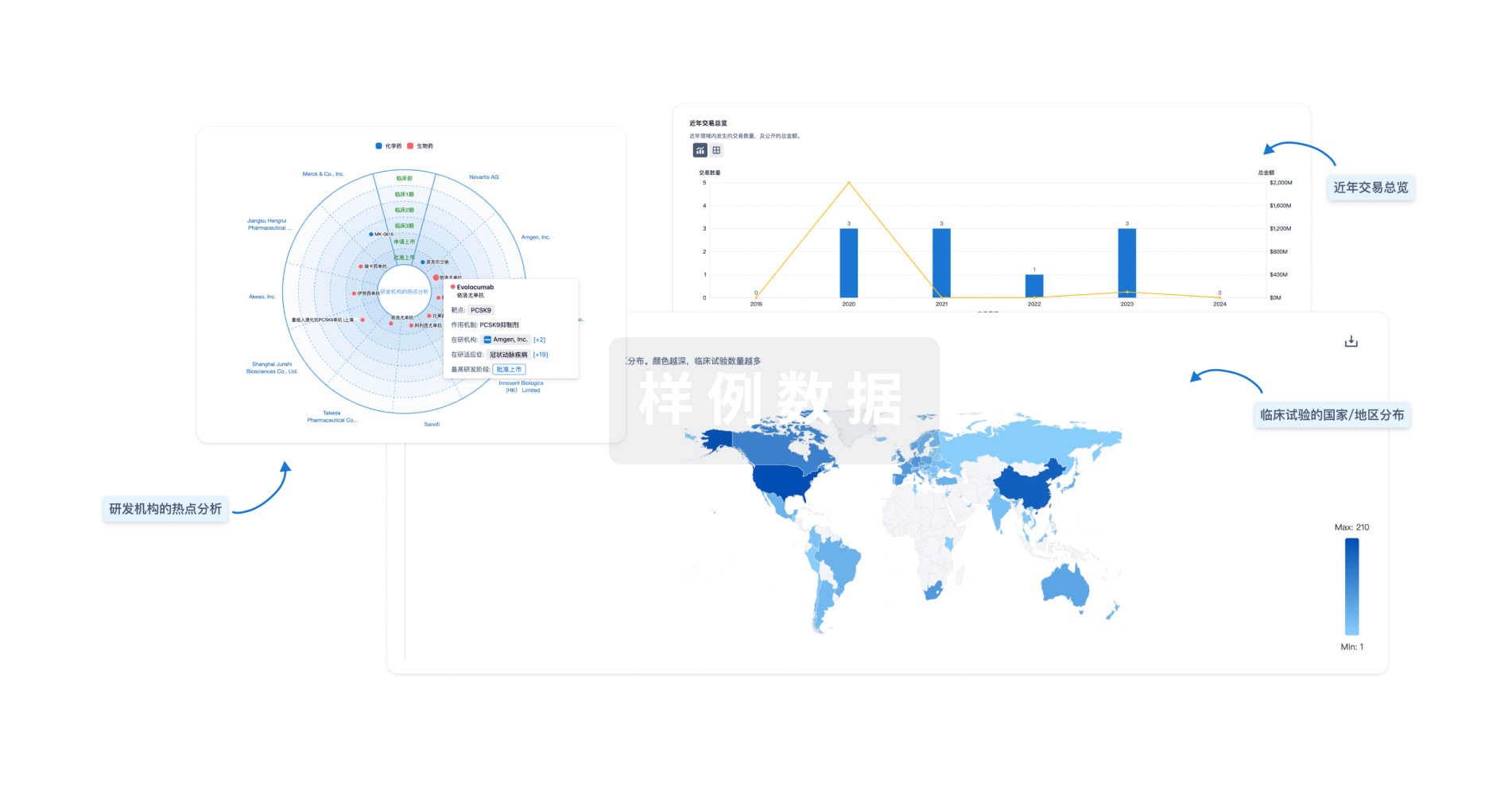预约演示
更新于:2025-05-07
IL-2 x Cytokine receptors
更新于:2025-05-07
基本信息
关联
5
项与 IL-2 x Cytokine receptors 相关的药物作用机制 IL-2替代物 [+2] |
原研机构 |
非在研适应症- |
最高研发阶段临床1期 |
首次获批国家/地区- |
首次获批日期1800-01-20 |
作用机制 CD20抑制剂 [+2] |
在研适应症 |
非在研适应症- |
最高研发阶段临床前 |
首次获批国家/地区- |
首次获批日期1800-01-20 |
作用机制 EBOV glycoprotein抑制剂 [+3] |
在研适应症 |
非在研适应症- |
最高研发阶段临床前 |
首次获批国家/地区- |
首次获批日期1800-01-20 |
3
项与 IL-2 x Cytokine receptors 相关的临床试验NL-OMON51485
A phase 1, first-in-human, 2-part, randomized, double-blind, placebo controlled, single ascending dose and sequential, open-label, multiple ascending dose study to evaluate the safety, tolerability, pharmacodynamics, and pharmacokinetics of VIS171 in healthy participants and participants with autoimmune disease(s) - VIS171
开始日期- |
申办/合作机构- |
NCT06799520
A Phase 1 Open-label Trial to Evaluate the Safety, Tolerability, Pharmacodynamics, Pharmacokinetics, and Immunogenicity of Subcutaneous VIS171 in Participants With Autoimmune Disease(s)
The purpose of this trial is to measure safety and tolerability of subcutaneous (SC) VIS171 in combination with standard of care in participants with autoimmune disease(s). The total duration of the clinical trial for each participant will be up to approximately 9 to 12 months.
开始日期2025-03-17 |
NCT05418101
A Phase 1, First-in-human, 2-part Study (part 1 is a Single Ascending Dose in Healthy Participants; Part 2 is a Multiple Ascending Dose Study in Participants with Autoimmune Disease) to Evaluate the Safety, PD and PK of VIS171
This is a phase 1 study to evaluate the safety, tolerability, pharmacodynamics, and pharmacokinetics of VIS171 in healthy participants and in participants with autoimmune disease(s).
开始日期2022-04-28 |
申办/合作机构 |
100 项与 IL-2 x Cytokine receptors 相关的临床结果
登录后查看更多信息
100 项与 IL-2 x Cytokine receptors 相关的转化医学
登录后查看更多信息
0 项与 IL-2 x Cytokine receptors 相关的专利(医药)
登录后查看更多信息
10,961
项与 IL-2 x Cytokine receptors 相关的文献(医药)2025-08-01·Theriogenology
FOXP3+ T cells and immune dysregulation in canine pyometra
Article
作者: Li, Zhiqiang ; Hu, Binhong ; Mei, Ling ; Li, Shangfeng ; Liu, Shiyi ; Zhao, Wei ; Özkan, Hüseyin ; Zhan, Jiasui ; Deng, Xin ; Yazlık, Murat Onur
2025-07-01·Journal of Neuroimmunology
Autoantigen and IL-2 activated CD4+CD25+T regulatory cells are induced to express CD8 and are autoantigen specific in inhibiting experimental autoimmune encephalomyelitis
Article
作者: Rakesh, Prateek ; Robinson, Catherine M ; Verma, Nirupama D ; Hall, Bruce M ; Tran, Giang T ; Hodgkinson, Suzanne J ; Carter, Nicole ; Bedi, Sukhandep ; Al-Atiyah, Ranje
2025-06-15·International Journal of Cancer
Delineation of monocytic and early‐stage myeloid‐derived suppressor cells in the peripheral blood of patients with hepatocarcinoma
Article
作者: Utrero‐Rico, Alberto ; Serrano, Manuel ; Alfocea‐Molina, Ángel ; González‐Cuadrado, Cecilia ; Arroyo‐Ródenas, Javier ; Mancebo, María Esther ; Del Rey, Manuel J. ; Paz‐Artal, Estela ; Laguna‐Goya, Rocio ; Caso, Oscar ; Ruigómez‐Martín, Carlota C. ; Chivite‐Lacaba, Marta ; Justo, Iago ; Pascual‐Palacios, Lorena
860
项与 IL-2 x Cytokine receptors 相关的新闻(医药)2025-04-30
·小药说药
PD-1/PD-L1基本信息PD-1:PD-1属于CD28超家族,由PDCD1基因编码,包含5个外显子。PD-1蛋白包含一个IgV型的胞外域、一个柄状结构域,一个跨膜域和一个胞内域,胞内域包含免疫受体酪氨酸基抑制性基序(ITIM)和免疫受体酪氨酸基开关基序(ITSM)。PD-L1:PD-L1属于B7家族,由CD274基因编码,是一个33kDa的I型跨膜蛋白,包含290个氨基酸残基。PD-L1包含IgV样和IgC样胞外域、一个疏水的跨膜域和一个短的胞内尾,其中也包含ITIM和ITSM基序。PD-1及其配体PD-L1的结构示意图PD-1在不同免疫细胞中的作用PD-1在T细胞、B细胞、NK细胞、树突状细胞(DCs)和巨噬细胞上的表达上调。PD-1与PD-L1结合后,通过招募SHP-2和SHP-1去磷酸化,阻断下游信号传导,从而抑制B细胞和T细胞的激活、增殖以及细胞因子产生,同时也抑制巨噬细胞、树突状细胞和自然杀伤细胞的功能。肿瘤细胞和树突状细胞均可表达PD-1和PD-L1。巨噬细胞上的PD-1可由脂多糖(LPS)刺激诱导。具体来说,PD-1在不同免疫细胞中的作用如下:T细胞:PD-1在T细胞激活、耐受和耗竭中起关键作用,影响肿瘤发生、炎症和感染。PD-1的异常表达与多种疾病相关,包括黑色素瘤、结直肠癌、非小细胞肺癌等。B细胞:PD-1通过抑制B细胞激活、增殖和细胞因子产生来调节B细胞功能。PD-1在B细胞中的异常表达与类风湿性关节炎、某些肿瘤和乙型肝炎相关。树突状细胞:PD-1在DCs上的表达与免疫抑制相关,影响T细胞的激活和功能。NK细胞:PD-1在NK细胞上的表达与多种病理状态相关,影响其抗肿瘤功能。巨噬细胞:PD-1在巨噬细胞上的表达与免疫抑制和肿瘤进展相关。其他细胞:PD-1在其他免疫细胞(如ILCs、单核细胞和中性粒细胞)中的作用仍在研究中。PD-1在不同免疫细胞中的作用示意图T细胞与PD-1/PD-L1轴T细胞通过TCR和PD-1的相互作用:a)PD-1与PD-L1是维持免疫平衡的关键分子。正常情况下,抗原呈递细胞(APCs)与T细胞的相互作用会阻断PD-1/PD-L1轴。在这种情况下,APCs会抑制其PD-L1与T细胞的PD-1的相互作用,通过与PD-1的结合,这种机制促进了T细胞通过其MHC-TCR和多条信号通路的正常活性,能够有效减少自身免疫细胞对自身组织的攻击。此外,PD-1/PD-L1在细胞黏附、迁移、记忆T细胞的形成以及代谢等诸多方面也发挥着重要作用,还参与组织和器官的发育、再生等过程。b)异常情况下,机体允许T细胞的PD-1与肿瘤细胞的PD-L1相互作用。在这种情况下,这种作用会阻断T细胞的正常作用途径,导致细胞因子产生功能障碍、增殖减少和细胞毒性降低,从而促进肿瘤的进展。T细胞与PD-1/PD-L1在不同情况下的作用机制示意图PD-1/PD-L1轴在肿瘤微环境中起着关键作用,通过中和免疫系统促进肿瘤进展和逃逸。PD-L1与T细胞上的PD-1结合会导致T细胞功能障碍、中和、耗竭以及IL-10的产生,从而促进肿瘤的生长。此外,PD-1/PD-L1轴激活PI3K/AKT、MAPK和JAK-STAT等信号通路,这些通路对细胞增殖、存活和免疫逃逸至关重要。PD-1/PD-L1轴的免疫逃逸机制:抗原呈递细胞(APCs)通过主要组织相容性复合体(MHC)将肿瘤抗原递呈给T细胞受体(TCR),当MHC-抗原复合物特异性地结合到TCR时,会触发一系列信号转导,包括磷脂酰肌醇信号通路和丝裂原活化蛋白激酶信号通路,从而激活效应T细胞的免疫反应。当PD-L1与PD-1结合时,PD-1细胞质区域的ITSM和ITIM结构域中的酪氨酸残基发生磷酸化,招募并激活SHP2。随后,被招募的SHP-2介导TCR相关CD3和ZAP70信号复合体的去磷酸化,同时抑制CD28共刺激信号。这进一步减弱了下游TCR信号强度和细胞因子(如IL-2)的分泌,最终抑制了T细胞的功能。免疫逃逸机制示意图PD-1/PD-L1的表达调控以及相关信号通路PD-1:PD-1的表达受到多种因素的调控,例如抗原信号刺激以及炎症因子等。在急性感染和慢性感染中,PD-1表达的调控机制存在显著差异。在肿瘤免疫环境中,持续的TCR信号刺激可促使PD-1表达上调,进而诱导免疫耐受的发生。PD-1信号通路概述:PD-1对TCR信号的影响:如上文所述。PD-1对γc家族细胞因子信号的影响:PD-1通过直接靶向γc来拮抗γc家族细胞因子介导的免疫激活,通过SHP-2去磷酸化γcY357,导致其失活,并通过MARCH5介导的K27连接多泛素化和溶酶体降解γc。PD-1信号通路简略示意图PD-1在肿瘤细胞中的复杂调控机制:a)肿瘤细胞内源性PD-1的细胞内信号传导。PD-1的免疫球蛋白样细胞外结构域与PD-L1的免疫球蛋白样细胞外结构域相互作用,触发下游信号通路,包括mTOR信号通路、Ras/MAPK信号通路、AKT/ERK信号通路、Hippo信号通路和Wnt/β-catenin信号通路。这些信号通路在多种生物学过程中发挥着关键作用,如增殖、凋亡、细胞周期进程、上皮-间质转化(EMT)、转移扩散、线粒体活性氧(mROS)的产生、放化疗耐药性的形成以及癌症干细胞特性的维持。例如,PD-1信号通路在肿瘤细胞中的激活可导致mTOR通路下游分子的磷酸化增加,如核糖体S6蛋白(p-S6)。这些信号通路中关键分子的磷酸化可以对肿瘤细胞的行为和特性产生一系列影响,促进肿瘤的进展、侵袭性以及对治疗干预的耐药性。b)翻译后调控。翻译后调控的一个关键方面是FBW7作为PD-1蛋白的E3泛素连接酶的作用。FBW7促进PD-1在Lys233残基处的K48连接的多泛素化,从而标记其被蛋白酶体降解。这一过程对于控制肿瘤细胞中PD-1蛋白的水平至关重要。另一个重要的翻译后调控机制涉及MDM2,它增强了糖基化PD-1与糖苷酶NGLY1之间的结合。这种相互作用促进了PD-1的脱糖基化和由NGLY1介导的泛素化降解。此外,由FUT8介导的PD-1上特定残基(N49和N74)的岩藻糖基化对于PD-1的功能性定位至关重要。核心岩藻糖基化的缺失与PD-1被泛素-蛋白酶体系统降解的增强有关。(c)转录调控。PDCD1的转录受到多种转录因子的调控,包括p53、YB-1、NF-κB、CYY61/CTGF和P300/CBP。PD-1在肿瘤细胞中的复杂调控机制PD-L1:基因层面:PD-L1启动子区域的表观遗传修饰,包括DNA甲基化、组蛋白甲基化和乙酰化,在PD-L1表达的调控中也起着重要作用。例如,TNF-α/TGF-β1通过降低DNMT1(DNA甲基转移酶)水平诱导PD-L1启动子的去甲基化,导致PD-L1上调,从而发挥免疫抑制作用。在转录水平上,PD-L1表达主要由转录因子调控,包括STAT、MYC、NF-κB、IRF1、AP-1和HIF-1α,以及信号通路效应分子,如MAPK/PI3K/Akt、JAK/STAT3和EGFR/MAPK。PD-L1基因水平上的表达调控示意图转录和翻译后修饰层面:非编码RNA(如miR-34、miR-200和miR-197)可以通过直接结合PD-L1的3'非翻译区(3'UTR)来抑制PD-L1 mRNA的表达。PD-L1 mRNA的m6A修饰对于调控PD-L1的表达和稳定性以及介导肿瘤免疫逃逸至关重要。例如,去甲基化酶(如FTO和ALKBH)可以去除PD-L1 mRNA上的m6A修饰,增加其稳定性,并促进PD-L1的高表达。METTL3/IGF2BP3轴通过上调PD-L1 mRNA的m6A修饰来增强其稳定性,从而进一步促进肿瘤免疫逃逸。此外,翻译后修饰,包括磷酸化、泛素化、糖基化和棕榈酰化,可以通过影响PD-L1蛋白在癌细胞中的活性、稳定性和膜表达来调控PD-L1蛋白的表达。PD-L1表达在转录后和翻译后的调控机制不同形式的表达层面:多种转录因子直接参与PD-L1表达的调节,影响其在不同细胞环境中的上调。一旦合成,PD-L1 mRNA转移到细胞质中,在那里被翻译成蛋白质,随后呈现在癌细胞表面。这种表达有助于免疫逃逸机制的关键相互作用。非编码RNA(如miRNA、circRNA和lncRNA)在诱导PD-L1降解方面发挥重要作用。这些ncRNA通过各种机制途径调节PD-L1的水平,从而降低其总体表达。PD-L1还被包裹在细胞外囊泡中,特别是以小囊泡的形式出现,介导细胞间通信并影响肿瘤动态。这种包裹途径通过促进免疫抑制信号的系统性传播,在推进肿瘤免疫逃逸策略中起到了关键作用。PD-L1多种形式的表达谱PD-1/PD-L1信号通路机制概述如下图:PD-1/PD-L1的病理作用机制PD-L1在癌症中的作用:PD-L1在多种癌症中表达上调,与肿瘤的侵袭性、增殖和预后不良相关。例如,在非小细胞肺癌(NSCLC)中,PD-L1的高表达与肿瘤增殖、侵袭性增加和患者生存率降低相关。在黑色素瘤中,PD-L1在恶性黑色素细胞和免疫细胞上的表达与免疫治疗的抗肿瘤反应相关。在膀胱癌中,PD-L1作为生物标志物与肿瘤分级和疾病进展相关。在前列腺癌中,PD-L1的表达在转移性去势抵抗性前列腺癌(mCRPC)中更高,被认为是高风险患者的不良预后标志物。PD-L1在癌症中的作用简图PD-L1对肿瘤发展的作用:PD-L1不仅促进肿瘤细胞逃避免疫监视,还能以免疫独立的方式促进肿瘤进展。在肿瘤细胞中高表达的PD-L1可以通过与核输入蛋白KPNB1结合进入细胞核,并发挥促癌作用。核PD-L1还可以触发免疫检查点基因(包括PD-L2和VISTA)的上调,从而增强PD-1抑制的抗肿瘤反应。在缺氧条件下,用TNFα和CHX处理可以促进PD-L1的核转位,然后PD-L1与p-Stat3-Y705相互作用。随后,p-Stat3-Y705结合到GSDMC启动子区域,导致GSDMC基因表达上调。此外,GSDMC被caspase-8裂解并激活,触发细胞焦亡以及肿瘤缺氧区域的坏死。PD-L1对肿瘤本身的影响PD-1/PD-L1在移植和自身免疫性疾病中的作用:在器官移植过程中,PD-1在移植组织中浸润的T细胞表面高度表达。PD-1/PD-L1介导的负性调节信号可以抑制T细胞的过度激活,诱导免疫耐受,并在术后有效减少宿主与供体之间的免疫排斥。阻断PD-1/PD-L1会促进移植组织中浸润的T细胞增殖,加剧移植后的免疫排斥反应,并导致严重且持续的组织损伤。同样,PD-1和PD-L1信号之间的平衡被打破也会导致许多自身免疫性疾病的发生,如1型糖尿病(T1DM)、多发性硬化症(MS)、系统性红斑狼疮(SLE)和类风湿关节炎(RA)。PD-1/PD-L1在移植和自身免疫性疾病中的作用示意图PD-1/PD-L1的致瘤机制:PD-1/PD-L1通路促进效应T细胞的耗竭和凋亡。耗竭的T细胞(Tex)表现为高表达抑制性受体(如PD-1、LAG3和TIGIT)、细胞因子(如TNF、IL-2和IFN-γ)分泌减少、代谢改变以及增殖能力和存活能力受损。PD-1/PD-L1通过降低PI3K/Akt/mTOR和S6的磷酸化,同时增强PTEN,促进诱导性调节性T细胞(iTregs)的生成和发展,从而增强Treg细胞的免疫抑制功能并诱导免疫耐受。PD-1/PD-L1可促进肿瘤相关巨噬细胞(TAM)向M2表型极化,释放大量成纤维细胞生长因子、VEGF、TNF-α等细胞因子,促进血管生成并支持癌细胞的免疫抑制、侵袭和转移,加速癌症进展。自然杀伤细胞(NK细胞)上的PD-1与癌细胞上的PD-L1结合,抑制NK细胞的脱颗粒和细胞毒性功能,降低其杀伤肿瘤细胞的能力,促进肿瘤免疫逃逸。使用PD-1和PD-L1抑制剂可能会重新激活上述免疫细胞的抗肿瘤免疫反应。PD-1/PD-L1信号通过对免疫细胞的调控导致肿瘤形成的机制示意图PD-1/PD-L1对肿瘤的代谢作用:PD-1/PD-L1信号通过破坏有氧糖酵解,改变细胞能量合成和代谢途径,从而促进脂肪酸氧化(FAO)成为T细胞的主要能量来源。此外,NAD⁺代谢组分NAMPT可以通过Stat1依赖的IFN-γ信号通路增强肿瘤细胞中PD-L1的表达,进而抑制T细胞功能,重塑局部肿瘤微环境,最终对肿瘤的转移、复发和预后产生显著影响。此外,肠道微生物组也可以改善肿瘤进展并增强T细胞免疫反应,提示其在提高PD-1阻断疗法效果方面的潜在应用价值。PD-1/PD-L1信号影响肿瘤代谢的示意图PD-1/PD-L1轴的免疫治疗策略靶向PD-1/PD-L1轴的单抗药物:靶向PD-1/PD-L1轴的双抗药物:BsAbs的分类和作用机制:BsAbs分为非IgG格式和IgG格式,IgG-like剂保留Fc介导的抗体效应功能,而Fc-free BsAbs缺乏这些功能。BiTEs(双特异性T细胞接合剂)和Triomabs是主要的BsAb格式。BsAbs的Fc域可能导致非靶向毒性,如细胞因子释放综合征(CRS)。抗TGFβ×PD-L1 BsAb:TGFβ在癌症免疫学和免疫治疗中扮演双重角色,既能抑制肿瘤发生,也能促进肿瘤进展。M7824是一种新型的双功能融合蛋白,结合了抗PD-L1域和TGFβ受体,同时靶向两个免疫抑制途径;M7824在非小细胞肺癌(NSCLC)患者中显示出显著的临床疗效。抗CD47×PD-L1 BsAb:CD47在肿瘤细胞上表达,向巨噬细胞传递“不要吃我”的信号。抗CD47×PD-L1 BsAb通过阻断CD47/SIRPα和PD-1/PD-L1信号通路,增强抗肿瘤免疫反应。抗VEGF/PD-1和抗VEGF/PD-L1 BsAb:VEGF由缺氧TME诱导,促进血管增生和免疫抑制。抗VEGF×PD-1和抗VEGF×PD-L1 BsAbs展示了在多种癌症中抑制血管生成和激活免疫反应的潜力。抗4-1BB×PD-L1 BsAb:4-1BB(CD137)是一种在激活的NK和T细胞上表达的共刺激分子。抗4-1BB×PD-L1 BsAb通过结合4-1BB激动剂与PD-1/PD-L1抑制剂,增强肿瘤特异性T细胞反应。抗LAG-3×PD-L1 BsAb:LAG-3在激活的T细胞和NK细胞上表达,传递抑制信号。抗LAG-3×PD-L1 BsAb通过阻断LAG-3和PD-1/PD-L1信号通路,增强抗肿瘤免疫反应。抗PD-1/CTLA-4 BsAb:CTLA-4和PD-1是抑制T细胞功能的免疫检查点。抗PD-1/CTLA-4 BsAb通过同时靶向PD-1和CTLA-4,增强抗肿瘤免疫反应。靶向PD-1/PD-L1轴的PROTACs:PROTACs是一种新型的药物设计技术,通过招募E3泛素连接酶来靶向降解特定蛋白质。包括Compound 22、AC-1、AbTACs、CDTACs、Compound 21a、Peptide-PROTACs、R2PD1、SP-PROTAC和Liner peptide PROTAC。这些PROTACs通过不同的机制降解PD-1/PD-L1蛋白,从而增强免疫治疗的效果。例如,Compound 22可以通过溶酶体依赖途径降解PD-L1蛋白,而AC-1可以通过招募RNF43 E3连接酶来降解PD-L1(如下图)。靶向PD-1/PD-L1轴的小分子抑制剂:联合治疗策略:1. 化疗与PD-1/PD-L1联合:化疗药物如蒽环类和奥沙利铂可诱导免疫原性细胞死亡,刺激抗肿瘤免疫反应。2. 放疗与PD-1/PD-L1联合:放疗可诱导免疫原性细胞死亡,增强T细胞浸润,扩大肿瘤微环境(TME)中的T细胞受体(TCR)库;放疗可上调肿瘤细胞上的PD-L1表达,增加MHC-I表达,缓解对PD-1/PD-L1抑制剂的耐药性。3. 抗血管生成抑制剂与PD-1/PD-L1联合:抗血管生成抑制剂可阻断促血管生成通路,促进血管正常化,改善肿瘤灌注和氧合,恢复缺氧的TME。抗血管生成抑制剂可重塑TME,促进T细胞浸润和树突状细胞(DC)成熟,增强M1型巨噬细胞分化,降低调节性T细胞(Treg)和髓系来源的抑制细胞(MDSC)比例。α-PD-1/PD-L1与化疗、放疗或抗血管生成抑制剂联合使用的协同抗肿瘤效果及机制示意图免疫耐药和副作用1.新辅助免疫治疗的疗效:新辅助免疫治疗,特别是免疫治疗联合化疗,比单药治疗或双免疫治疗能获得更高的ORR、MPR和pCR。例如,在头颈部癌症中,NCT03342911试验显示,nivolumab联合化疗的MPR为65%,pCR为35%。在乳腺癌中,KEYNOTE-522试验显示,pembrolizumab联合化疗的pCR为60%。2. 不良事件:尽管新辅助免疫治疗导致TRAEs增多,但大多数是可接受的,并且不会显著延迟手术。例如,在NCT02919683试验中,nivolumab联合ipilimumab治疗口腔鳞状细胞癌(OCSCC)的ORR为38%,MPR为4%,pCR为3%,且大多数患者经历了irAEs,但没有导致手术延迟。3. 病理缓解与生存率:研究发现,新辅助免疫治疗后达到病理缓解的患者,术后DFS较未达到病理缓解的患者有所提高。例如,在NCT02641093试验中,pembrolizumab联合化疗的ORR为8%,MPR为27%,pCR为13%。4. PD-1与PD-L1抑制剂的比较:在大多数实体瘤中,PD-1和PD-L1单药治疗的疗效没有显著差异,但PD-L1治疗引起的irAEs发生率显著低于PD-1。例如,在肺癌中,PD-1单药治疗的ORR为25%,而PD-L1单药治疗的ORR为22%。5. 手术相关并发症:大多数试验中未报告治疗相关的手术延迟。一些患者因疾病进展、严重的TRAEs或高手术风险而未接受手术,或拒绝手术。新辅助免疫治疗的ORR、MPR、pCR和不良事件PD-1/PD-L1轴在不同适应症的应用PD-1/PD-L1轴在多种适应症中都有应用肿瘤领域• 非小细胞肺癌(NSCLC):PD-1/PD-L1抑制剂已成为晚期NSCLC的重要治疗手段。如帕博利珠单抗被批准用于PD-L1高表达(TPS≥50%)的初治晚期NSCLC患者的一线治疗,其通过阻断PD-1/PD-L1轴,增强T细胞对肿瘤细胞的识别和杀伤能力,延长患者生存期。此外,阿特珠单抗联合化疗也被用于晚期NSCLC的一线治疗,可提高疗效和生存率。• 小细胞肺癌(SCLC):度伐利尤单抗联合化疗在SCLC的治疗中显示出一定疗效,能够延长患者的无进展生存期和总生存期,为SCLC患者提供了新的治疗选择。• 黑色素瘤:纳武利尤单抗和帕博利珠单抗等PD-1抑制剂在黑色素瘤的治疗中取得了显著成效,可显著提高患者的客观缓解率和生存率,已成为晚期黑色素瘤的一线治疗药物。此外,PD-1抑制剂还可与CTLA-4抑制剂联合使用,进一步增强免疫治疗效果。• 肾癌:PD-1/PD-L1抑制剂在肾癌的治疗中也显示出良好的疗效。例如,阿特珠单抗联合贝伐珠单抗被批准用于晚期肾癌的一线治疗,其通过双重免疫机制,抑制肿瘤血管生成和增强抗肿瘤免疫反应,延长患者生存期。• 膀胱癌:阿特珠单抗是首个被批准用于膀胱癌的PD-L1抑制剂,可用于治疗局部晚期或转移性膀胱癌,特别是对铂类化疗耐药或不耐受的患者,可显著提高患者的客观缓解率和生存率。• 头颈部鳞状细胞癌(HNSCC):帕博利珠单抗被批准用于复发或转移性HNSCC的治疗,其通过阻断PD-1/PD-L1轴,增强T细胞对肿瘤细胞的攻击,延长患者生存期。• 结直肠癌(CRC):纳武利尤单抗可用于治疗微卫星高度不稳定(MSI-H)或错配修复缺陷(dMMR)的晚期CRC患者,为这部分患者提供了新的治疗选择。• 肝细胞癌(HCC):纳武利尤单抗单药或联合伊匹木单抗被批准用于晚期HCC的治疗,其通过激活免疫系统,增强对肿瘤细胞的识别和杀伤能力,延长患者生存期。• 胃癌:帕博利珠单抗被批准用于PD-L1 CPS≥1的晚期胃癌或胃食管结合部癌的一线治疗,以及用于二线治疗复发或难治性胃癌患者,可显著提高患者的客观缓解率和生存率。• 食管癌:帕博利珠单抗和纳武利尤单抗等PD-1抑制剂在晚期食管癌的治疗中也显示出良好的疗效,可延长患者的生存期。• 妇科肿瘤:如子宫内膜癌,多塔利单抗被批准用于治疗错配修复缺陷(dMMR)或微卫星高度不稳定(MSI-H)的复发或晚期子宫内膜癌患者,为这部分患者提供了新的治疗选择。• 软组织肉瘤:PD-1/PD-L1抑制剂在软组织肉瘤的治疗中也进行了相关研究,但目前其疗效尚存在一定的争议,部分研究显示PD-L1表达水平可能与治疗反应相关,但不同研究结果存在差异,仍需进一步探索。• 儿童肿瘤:在儿童肿瘤中,PD-L1表达在一些儿童血液肿瘤如霍奇金淋巴瘤、弥漫大B细胞淋巴瘤、急性髓系白血病、急性淋巴细胞白血病和胶质瘤中有所观察到。目前也有相关的临床试验在探索PD-1/PD-L1抑制剂在儿童肿瘤中的应用,如纳武利尤单抗在儿童淋巴瘤中显示出一定的疗效,但在其他儿童实体瘤中单药治疗的活性有限。自身免疫性疾病领域• 系统性红斑狼疮(SLE):有研究表明,SLE患者中PD-1/PD-L1轴的表达存在异常,PD-1/PD-L1轴的调节可能有助于控制SLE的病情活动。一些研究正在探索PD-1/PD-L1抑制剂在SLE治疗中的潜在应用,但目前仍处于早期研究阶段。• 类风湿关节炎(RA):PD-1/PD-L1轴在RA的发病机制中也发挥着重要作用,其调节可能有助于减轻RA患者的炎症反应和关节损伤。相关研究正在进行中,以评估PD-1/PD-L1抑制剂在RA治疗中的安全性和有效性。神经系统疾病领域• 阿尔茨海默病(AD):研究表明,PD-1/PD-L1轴在AD的发病过程中可能参与调节神经炎症反应。通过调节PD-1/PD-L1轴,可能有助于减轻神经炎症,改善认知功能。目前,相关研究仍在探索阶段,以确定PD-1/PD-L1抑制剂在AD治疗中的潜在应用价值。• 帕金森病(PD):PD-1/PD-L1轴在帕金森病的发病机制中也受到关注。其调节可能对帕金森病的神经保护和疾病进展产生影响,但目前仍处于基础研究阶段,尚未进入临床应用。其他领域• 感染性疾病:在某些慢性感染性疾病中,如HIV感染、结核病等,PD-1/PD-L1轴的过度激活可能导致免疫细胞的耗竭。通过调节PD-1/PD-L1轴,可能有助于恢复免疫细胞的功能,增强机体对病原体的清除能力。相关研究正在进行中,以探索PD-1/PD-L1抑制剂在感染性疾病治疗中的潜在应用。• 心血管疾病:PD-1/PD-L1轴在动脉粥样硬化等心血管疾病的发生发展中可能发挥一定作用。其调节可能对炎症反应和血管内皮功能产生影响,从而影响心血管疾病的进程。目前,相关研究仍在探索阶段,以确定PD-1/PD-L1抑制剂在心血管疾病治疗中的潜在应用价值。公众号内回复“ADC”或扫描下方图片中的二维码免费下载《抗体偶联药物:从基础到临床》的PDF格式电子书!公众号已建立“小药说药专业交流群”微信行业交流群以及读者交流群,扫描下方小编二维码加入,入行业群请主动告知姓名、工作单位和职务。
免疫疗法细胞疗法
2025-04-29
·抗体圈
这篇文章于2022年发表在ImmuneNetw.,主要总结了自身免疫性疾病靶向免疫治疗最新进展。摘要: 在过去的几十年里,靶向炎性细胞因子、免疫细胞和细胞内激酶的生物药物和小分子抑制剂已成为治疗自身免疫性疾病的标准护理。抑制TNF、IL-6、IL-17和IL-23彻底改变了类风湿性关节炎、强直性脊柱炎和银屑病等自身免疫性疾病的治疗。使用抗CD20mAb的B细胞耗竭疗法在神经炎症性疾病患者中显示出有希望的结果,抑制B细胞存活因子被批准用于治疗系统性红斑狼疮。靶向Ag呈递细胞和T细胞上表达的共刺激分子也有望通过调节T细胞功能在自身免疫性疾病中具有治疗潜力。 最近,靶向JAK家族(负责多个受体信号转导)的小分子激酶抑制剂在自身免疫和血液疾病领域引起了极大的兴趣。然而,在治疗效果和安全性方面仍存在未满足的医疗需求。新兴疗法旨在使用先进的分子工程技术在不影响免疫功能的情况下诱导免疫耐受。【NO.1】背景介绍 自身免疫性疾病是以自身抗原炎症失调为特征的病理性疾病,影响3%-10%的普通人群。自身免疫性疾病的常规治疗方法抑制了一般免疫功能以调节不受控制的炎症。然而,这些治疗方法在异质性患者群体中并未完全成功,其疗效以牺牲副作用为代价,特别是感染风险增加,通常来自非选择性免疫抑制。为了克服传统疗法的局限性,目前的治疗方法旨在更选择性地抑制炎症信号,同时最大限度地减少对稳态免疫功能的破坏。 最近在了解疾病发病机制和新药制造技术方面取得的进展导致靶向免疫疗法广泛用于治疗自身免疫性疾病。此外,先进的分子工程技术催生了靶向可溶性介质或细胞表面标志物的重组蛋白治疗药物,如mAb和receptor-Ab融合蛋白。自1990年代首次批准靶向TNF的选择性蛋白质疗法用于类风湿性关节炎(RA)以来,靶向免疫疗法已成为治疗自身免疫性疾病的游戏规则改变者。根据全球药品市场报告,阿达木单抗多年来一直是全球最畅销的药物,其次是其他靶向免疫疗法,如pembrolizumab、ibrutinib和ustekinumab。 随着对疾病发病机制的了解迅速增加,许多靶向炎症信号通路的生物药物正在开发中,以治疗顽固性炎症性疾病。在成功引入生物疗法治疗自身免疫性疾病后,分子靶点已扩展到细胞内激酶。小分子激酶抑制剂阻断收敛信号在治疗效果和长期安全性方面具有重要意义。 本文总结了目前针对自身免疫性疾病发病机制中涉及的信号通路的治疗方法,并介绍了旨在诱导免疫耐受的新兴免疫疗法。由于靶向免疫疗法市场正在迅速增长,因此我们专注于已获得临床批准用于治疗自身免疫性疾病的药物。【NO.2】自身免疫性疾病中的炎症 炎症是生物体修复组织损伤并防止外来物质侵害的自然过程。然而,针对自身抗原的免疫反应失调会导致免疫耐受丧失和自身免疫性疾病的发展。自身免疫源于耐受性检查点的中枢和外周缺陷以及不耐受免疫细胞的激活。自身抗原可通过从免疫特权位点释放自身抗原、产生新自身抗原以及自身蛋白与外来物质的分子模拟来诱导。 自身免疫的临床表现多种多样,从存在自身抗体的无症状疾病到导致危及生命的器官损伤的暴发性自身免疫性疾病。自身免疫性疾病的发展可由遗传易感个体的环境因素触发。环境触发因素,包括压力、吸烟和感染,会诱导先天免疫的促炎功能,并促进适应性免疫的病理反应。 尽管自身免疫的传统概念是适应性免疫系统的失调,但越来越多的证据表明,先天免疫系统对自身免疫性疾病的发生和发展也至关重要。作为先天免疫的关键参与者,巨噬细胞和树突状细胞(DC)对于抗原呈递和促炎细胞因子(如TNF、IL-1β、IL-6、IL-23、B细胞激活因子(BAFF,也称为Blys或TNFSF13B)和增殖诱导配体(APRIL,也称为TNFSF13A)的产生至关重要。1型IFN与系统性红斑狼疮(SLE)及其相关疾病的发病机制密切相关,主要由浆细胞样DC(pDC)产生,浆细胞样DC是DC的一个特殊亚群。巨噬细胞/DC和T细胞/B细胞之间的相互作用进一步促进了自身免疫性炎症。 初始CD4+Th细胞根据细胞因子环境分化为不同的T细胞亚群。T细胞通过自身抗原识别、细胞因子产生和增强的细胞毒性,在自身免疫性疾病的发病机制中发挥关键作用。近几十年来,产生IL-17和FOXP3+Tregs的Th17细胞已被强调为自身免疫性疾病的治疗靶点。 自身反应性B细胞是适应性免疫的另一个主要组分,它产生病理性自身抗体,并通过Ag呈递和细胞因子产生激活T细胞。自身抗体的产生是各种自身免疫性疾病(包括RA和SLE)的标志。RA中的抗瓜氨酸肽抗体和SLE中的抗dsDNA抗体是导致临床表现和疾病活动度的代表性致病性自身抗体。由于B细胞在自身免疫中的重要作用,B细胞表面分子是各种自身免疫性疾病的治疗靶点。 来自活化免疫细胞的可溶性介质通过与它们的同源受体结合来转导炎症信号。一旦被炎性细胞因子结合,受体就会激活JAK家族,以诱导STAT的磷酸化、二聚化和核转位。STAT的基因转录促进细胞增殖和分化以及多种炎症介质的产生,进一步加剧自身免疫性炎症。 尽管每种自身免疫性疾病的病理生理机制不同,但几种常见的炎症途径可能是免疫治疗的治疗靶点。基于我们目前对自身免疫性炎症发病机制的理解,治疗自身免疫性疾病的关键治疗靶点如图1所示。表1、2、3列出了已批准用于自身免疫性疾病或正在临床开发的靶向免疫疗法,具体如下。本文重点介绍靶向免疫治疗在免疫介导的炎症性疾病领域的临床应用。图1.自身免疫性疾病发病机制中的关键治疗靶点表1.用于治疗自身免疫性疾病的细胞因子靶向疗法靶细胞因子结构药物临床应用正在调查中(IIb或III期)TNF-ɑsTNFR2-IgG1Fc依那西普RA、pJIA、AS、银屑病、PsA抗TNF单克隆抗体英夫利昔单抗RA、AS、银屑病、PsA、UC、CD超说明书使用:BD、结节病阿达木单抗RA、pJIA、AS、银屑病、PsA、UC、CD、化脓性毛突炎、葡萄膜炎超说明书使用:BD戈利木单抗RA、AS、PsA、UC赛妥珠单抗RA、AS、银屑病、PsA、CDIL-1IL-1R拮抗剂阿那白滞素RA、大写字母川崎病(NCT04656184)超说明书使用:AOSD、sJIA、痛风、复发性心包炎等IL-1R1-IgGFc利洛西普CAPS、DIRA、复发性心包炎超说明书使用:AOSD、痛风等IL-1β抗体抗卡纳单抗AOSD、sJIA、CAPS、TRAPS、HIDS/MKD、FMFCOVID19相关CRS(12)超说明书使用:痛风和许多其他IL-6(英语)IL-6单克隆抗体抗体西鲁尤单抗RA(13,14)*奥洛珠单抗RA(15)(NCT02760407,NCT02760433,NCT03120949)克拉扎奇珠单抗RA(NCT02015520)PsA(16)COVID19相关CRS(NCT04343989)西妥昔单抗CAR-T相关CRS(NCT04975555)IL-6R抗体抗体托珠单抗RA、sJIA、pJIA、SSc相关ILD、巨细胞动脉炎、CRSPMR(NCT02908217)超说明书使用:AOSD、Takayasu动脉炎NMOSD(17)COVID19肺炎(18,19)(NCT04409262)沙利尤单抗RA类COVID19相关CRS(20)(NCT04315298)沃巴利珠单抗RA(NCT02518620)IL-17(英语)IL-17单克隆抗体抗体依奇珠单抗银屑病、PsA、轴向SpA苏金单抗AS、银屑病、PsA系统性红斑狼疮(NCT04181762)轴向SpA(21)(NCT04156620,NCT04732117)Hiradenitissupprativa(NCT03713619,NCT03713632,NCT04179175)巨细胞动脉炎(NCT04930094)Grave眼病(NCT03713619)IL-17R抗体溴达利尤单抗牛皮癣轴向SpA(22)PsA(23)不锈钢(NCT03957681)IL17A/F抗体比莫珠单抗AS(NCT03928743)轴向SpA(NCT03928704,NCT04436640)银屑病(24,25)(NCT03598790,NCT03766685)PsA(NCT03895203、NCT03896581、NCT04009499NCT04109976)Hiradenitissuppruativa(NCT04242446,NCT04242498,NCT04901195)IL-23抗p40mAb抗体乌司奴单抗银屑病、PsA、UC、CD特发性炎性肌炎(NCT03981744)高安动脉炎(NCT04882072)抗p19mAb抗体古塞利尤单抗银屑病,PsAUC(NCT04033445)CD(NCT03466411,NCT04397263)瑞沙珠单抗牛皮癣PsA(26,27)UC(NCT03398135,NCT03398148)CD(NCT03104413、NCT03105102、NCT03105128NCT04524611)替尔拉奇珠单抗牛皮癣PsA(NCT03552276、NCT04314544、NCT04314531NCT04991116)米利珠单抗银屑病(NCT03482011、NCT03535194NCT03556202)UC(NCT03518086、NCT03519945NCT03524092)CD(NCT03926130,NCT04232553)1型IFN抗IFNR1单克隆抗体Anifrolumab系统性红斑狼疮备注:该表包括具有一种或多种已批准自身免疫性疾病适应症的药物。该适应症仅涵盖自身免疫性疾病领域。pJIA,多关节幼年特发性关节炎;UC,溃疡性结肠炎;CD,克罗恩病;BD,白塞病;sJIA,系统性幼年特发性关节炎;DIRA,IL-1受体拮抗剂缺乏;TRAPS,TNF受体相关周期性综合征;HIDS/MKD、高免疫球蛋白D综合征/甲羟戊酸激酶缺乏症;FMF,家族性地中海热;CRS,细胞因子释放综合征;CAR-T,嵌合Ag受体-T细胞;SSc相关ILD、系统性硬化症相关间质性肺病、PMR、风湿性多肌痛、NMOSD、视神经脊髓炎谱系疾病;中轴型SpA,中轴型脊柱关节炎。*尽管III期临床试验取得了积极结果,但由于安全性问题,FDA并未推荐将sirukumab用于治疗RA。表2.用于治疗自身免疫性疾病的细胞靶向疗法靶细胞结构药物临床应用正在调查中(IIb或III期)B细胞抗CD20mAb抗体利妥昔单抗RA类寻常型天疱疮(28)GPA、MPA超说明书使用:MS、免疫性血小板减少症奥瑞珠单抗女士奥法木单抗女士乌布利妥昔单抗MS(NCT03277261、NCT03277248NCT04130997)抗CD19mAb抗体因比利珠单抗NMOSDIgG4RD(NCT04540497)重症肌无力(NCT04524273)抗BAFF单克隆抗体贝利尤单抗系统性红斑狼疮抗BAFF-R单克隆抗体伊那单抗系统性红斑狼疮(NCT05126277)pSS(29)T细胞CTLA4-IgG1Fc阿巴西普RA,pJIApSS(NCT02067910,NCT02915159)PsA(30)特发性炎性肌炎(NCT02971683)GPA(NCT02108860)CD40mAb抗体伊斯卡利单抗pSS(NCT03905525)备注:该表包括已批准用于自身免疫性疾病或基于II期试验的积极结果正在临床开发的药物。GPA,肉芽肿性多血管炎;MPA,显微镜下多血管炎;NMOSD,视神经脊髓炎谱系疾病;IgG4RD,免疫球蛋白G4相关疾病;pJIA,多关节幼年特发性关节炎。表3.用于治疗自身免疫性疾病的激酶靶向疗法靶标激酶结构药物临床应用正在调查中(IIb或III期)杰克JAK1/3抑制剂托法替布RA类贾(31)(NCT01500551,NCT03000439)PsAAS(32))UC(英语)JAK1/2抑制剂巴瑞替尼RA类系统性红斑狼疮(NCT03843125,NCT03616912,NCT03616964)JIA(NCT03773965,NCT03773978)sJIA(NCT04088396)特应性皮炎(33,34)葡萄膜炎(NCT04088409)JAK1选择性抑制剂乌帕替尼RA类CD(NCT03345823、NCT03345836NCT03345849)PsA加州大学(35)(NCT03006068,NCT03653026)轴向SpA(NCT04169373)特应性皮炎(36,37)(NCT03661138,NCT04195698)高安动脉炎(NCT04161898)巨细胞动脉炎(NCT03725202)非戈替尼RA(由EMA和日本提供)统一(38)(NCT02914535)CD(NCT02914561,NCT02914600)TYKTYK2选择性抑制剂Deucravacitinib银屑病(NCT03624127,NCT03611751)PsA(NCT04908189,NCT04908202)BTK公司BTK抑制剂Evobrutinib(依布替尼)MS(NCT04338022,NCT04338061)托布替尼MS(NCT04410978、NCT04410991、NCT04411641NCT04458051)重症肌无力(NCT05132569)非布替尼MS(NCT04544449、NCT04586010NCT04586023)利扎布替尼寻常型天疱疮(NCT03762265)免疫性血小板减少症(NCT04562766)备注:该表包括已批准用于自身免疫性疾病或基于II期试验的积极结果正在临床开发的药物。UC,溃疡性结肠炎;sJIA,系统性幼年特发性关节炎;CD,克罗恩病;中轴型SpA,中轴型脊柱关节炎。【NO.3】细胞因子靶向治疗肿瘤坏死因子(TNF) TNF是一种主要由髓系细胞和活化T细胞产生的促炎细胞因子。RA滑膜中TNF表达的增加和TNF转基因小鼠中关节炎的发展表明TNF在慢性炎症中的致病作用。抗TNF治疗的成功彻底改变了RA患者的治疗策略。自1998年英夫利昔单抗和依那西普首次获批以来,已有4种单克隆抗体(英夫利昔单抗、阿达木单抗、戈利木单抗和赛妥珠单抗)和1种受体-Fc融合蛋白(依那西普)获批,目前可用于治疗慢性免疫介导的疾病,包括RA、幼年特发性关节炎(JIA)、强直性脊柱炎(AS)、银屑病和银屑病关节炎(PsA)。这种mAb也适用于治疗炎症性肠病和非感染性葡萄膜炎。 尽管TNF具有促炎作用,但它是一种多效性细胞因子,依赖于TNF受体(TNFR)的结合。TNFR1在几乎所有有核细胞上组成性表达,主要负责TNF的炎症功能,而TNFR2仅在特定细胞类型上表达,例如髓源性抑制细胞、Treg细胞和单核细胞,与TNF的调节功能相关。源自TNFR1和TNFR2的不同信号转导通路已在其他地方进行了综述。目前可用的抗TNF疗法同时抑制TNFR1和TNFR2。由于TNF的调节方面,TNF阻断可能反常地诱导Th1/Th17细胞扩增和IFN反应失调,这可以解释抗TNF治疗期间治疗失败、自身抗体生成和反常银屑病的原因。因此,正在研究抑制TNFR1和增强TNFR2的更多选择性治疗。IL-1 IL-1α和IL-1β是IL-1家族的成员,是促炎细胞因子,与先天免疫反应密切相关。尽管IL-1α和IL-1β通过与IL-1受体1(IL-1R1)结合而具有共享生物学功能,但IL-1α与IL-1β的几个特征是不同的。在间充质细胞中组成型表达的pro-IL-1α具有生物活性,而巨噬细胞产生的pro-IL-1β需要被caspase-1切割才能成为活性IL-1β。pro-IL-1β的Caspase-1依赖性裂解是通过激活包含核苷酸结合结构域成员和包含亮氨酸富集重复序列的[NLR]蛋白家族(例如NLR家族含pyrin结构域的[NLRP]1、NLRP3、NLR家族CARD结构域4)或包含PYRIN-HIN-200结构域的蛋白家族成员(例如,在黑色素瘤2中不存在)的炎性小体激活来介导的)。此外,与IL-1β相反,IL-1α在体循环中未检测到,这表明IL-1α在自身免疫性疾病中的致病作用是局部的,而不是全身的。目前,IL-1β被认为比IL-1α与多种风湿性疾病更密切相关,包括全身性JIA、成人发病斯蒂尔病(AOSD)和痛风,以及与遗传性自身炎症性疾病的相关性,例如冷热蛋白相关周期性综合征(CAPS)和家族性地中海热。 被IL-1α或IL-1β占据后,IL-1R1与IL-1R3形成异源三聚体复合体,以募集髓样分化初级反应基因88(MYD88),从而触发随后的激酶级联反应(IL-1R相关激酶[IRAK]、IκB激酶、IκB和NF-κB),从而促进促炎状态。IL-1的这种炎症活性受来自同一IL-1家族的天然IL-1R拮抗剂(IL-1Ra)的调节。IL-1Ra占据IL-1R1导致构象变化,阻碍异源三聚体复合物与IL-1R3的形成,从而阻碍IL-1介导的炎症过程。 目前,已有3种蛋白质疗法被批准用于抗IL-1疗法:canakinumab,一种抗IL-1βmAb;anakinra,一种重组IL-1受体拮抗剂;和rilonacept,一种IL-1R1-Fc融合蛋白。根据它们的分子结构,所有3种药物都阻断IL-1β,阿那白滞素和利洛西普也抑制IL-1α。作为一种抑制IL-1信号转导的新治疗方法,口服NLRP3抑制剂,包括达潘舒腈(OLT177),正在研究中。 在早期临床开发中,阿那白滞素被测试为RA的治疗方法。尽管阿那白滞素在RA患者中的治疗效果已得到证实,但由于其成本效益低,因此不推荐将阿那白滞素作为一线生物疗法。抗IL-1疗法更广泛地用于自身炎症性疾病,如全身性JIA、AOSD和CAPS。其他具有高炎症负荷的疾病,例如痛风和复发性心包炎,也可通过IL-1靶向治疗进行控制。由于IL-1在炎症性疾病中的广泛作用,IL-1阻断有望在治疗顽固性自身免疫性疾病(包括SLE和系统性硬化症)以及控制过度的促炎反应(如细胞因子释放综合征和巨噬细胞激活综合征)方面提供临床益处。IL-6 IL-6是一种多效性细胞因子,由各种细胞类型在感染、炎症和恶性肿瘤的情况下产生。IL-6最初被鉴定为T细胞分泌的“B细胞分化因子”或“B细胞刺激因子”。尽管抗IL-6疗法在B细胞成熟中起着关键作用,但其对多发性骨髓瘤患者的治疗效果不佳。然而,托珠单抗(第一种抗IL-6R阻断单克隆抗体)的IL-6靶向治疗被证明在RA中具有显着的临床益处,甚至在疗效上优于阿达木单抗。托珠单抗目前被批准用于治疗RA、JIA、AOSD、巨细胞动脉炎和细胞因子释放综合征,因为它能够调节全身性过度炎症。最近,已研究抗IL-6疗法在SLE、视神经脊髓炎和系统性硬化症中的治疗应用。 IL-6在生理和病理条件下具有多种生物学功能。在生理状态下,IL-6负责巨噬细胞分化为M2状态,通过成骨细胞上RANK配体表达的增加进行破骨细胞生成,以及通过肝脏中的JAK-STAT通路进行急性期反应。在病理(炎症)条件下,IL-6通过调节FOXP3、RORC和IL-23R表达,关键参与Th17分化。IL-6对滤泡辅助性T细胞的发育和B细胞的成熟也很重要。 IL-6信号转导通过IL-6R和糖蛋白130(gp130)的复合物转导。gp130二聚化依次激活多个信号转导通路,包括JAK-STAT、MAPK、PI3K和YES相关蛋白1,这些蛋白转位到胞核并控制与细胞生长、增殖和炎症相关的基因转录。为了干扰IL-6信号通路,抗IL6疗法可以靶向IL-6、IL-6R、gp130、JAK和STAT3。然而,对副作用的担忧限制了gp130和STAT3作为治疗靶点的潜力。因此,抗IL6mAb、抗IL-6RmAb和JAK抑制剂已被用于阻断IL-6信号转导,并且使用可溶性gp130抑制IL-6/IL-6R复合体的可能性正在研究中。IL-17 IL-17A,通常称为IL-17,是CD4+T细胞Th17亚群的标志性细胞因子,但它也由CD8+T细胞(Tc17)、γδT细胞、自然杀伤T细胞、第3组先天性淋巴细胞和中性粒细胞产生。在生理状态下,Th17细胞通过募集中性粒细胞、宿主对细菌和真菌的防御以及皮肤和粘膜部位的组织修复来促进先天免疫。在病理条件下,IL-17A与TNF和其他炎性趋化因子协同作用,促进自身免疫。炎症性关节炎和神经炎症的动物模型表明,Th17细胞而不是Th1细胞在这些疾病的发展中起主要作用。 Th17细胞在IL-1β、IL-6和TGF-β存在下,通过抑制FOXP3并激活STAT3和RORC来源于初始CD4+初始T细胞。随后,IL-23稳定致病性Th17细胞的增殖和存活。与IL-17A结合后,IL-17R亚基A(IL-17RA)和亚基C(IL-17RC)的称为SEF/IL-17R的独特胞质结构域募集接头蛋白Act1,从而触发TNF受体相关因子(TRAF)6的泛素化,随后激活NF-κB、MAPK和激活蛋白1(AP1)通路和C/EBP转录因子。 来自动物和人类研究的越来越多的证据表明,IL-23/IL-17轴是多种自身免疫性疾病(如AS、PsA和RA)的极好治疗靶标。目前的抗IL-17疗法包括IL-17A(苏金单抗和依奇珠单抗)和IL-17RA(brodalumab)的mAb。正如预期的那样,抗IL-17疗法在银屑病、PsA和AS中产生了显著的反应。出乎意料的是,这种方法在RA(一种Th17依赖性疾病)患者中未能显示出显着的临床疗效。这种不令人满意的结果可以通过疾病本身的异质性或IL-17A的不同致病作用来解释,具体取决于RA分期(例如早期与晚期)。IL-23 IL-23是一种由DC和活化的巨噬细胞分泌的促炎细胞因子。作为IL-12家族的一员,IL-23是一种异二聚体,由IL-12共有的p40亚基(IL-12/IL-23p40)和IL-23特有的p19亚基(IL-23p19)组成。尽管IL-12和IL-23共享一个结构亚基,但IL-23更重要、更广泛地参与自身免疫性疾病的发病机制。最重要的是,IL-23通过维持Th17特征基因、抑制抑制因子、上调IL-23R表达和诱导效应基因来稳定Th17细胞的致病特征。它还作为自分泌因子促进DC和巨噬细胞的促炎功能。 IL-23与由IL-12Rβ1(与IL-12/IL-23p40结合)和IL-23R(与IL-23p19结合)组成的受体复合体相互作用,它们分别与酪氨酸激酶(TYK)2和JAK2结合。TYK2和JAK2的激活导致STAT的磷酸化和核转位,主要是STAT3。通过靶向抑制IL-12/IL-23p40或IL-23p19,可以阻断IL-23信号传导。作为一种抗IL-12/IL-23p40mAb,乌司奴单抗可阻断IL-12和IL-23,而抗IL-23p19mAb(guselkumab、tildrakizumab、risankizumab和mirikizumab)仅抑制IL-23。 与抗IL-17治疗类似,IL-23抑制可有效治疗银屑病和PsA。然而,与抗IL17治疗相比,靶向p40和p19亚基的mAb均未能改善AS的临床病程。尽管IL-23在AS的临床前模型中具有明显的致病作用,但这种意外结果表明,IL-23在人类自身免疫性疾病的组织和时间依赖性环境中发挥着不同的作用。在克罗恩病中,乌司奴单抗成功改善了临床结局,抗IL-23p19mAb的临床试验正在进行中(表1)。1型IFN 1型IFN,包括IFN-α、IFN-β、IFN-ε、IFN-κ和IFN-ω,最初被鉴定为可溶性抗病毒因子。随后的研究表明,IFN-α在自身免疫性疾病,尤其是SLE的发病机制中起着至关重要的作用。SLE患者的临床数据显示1型IFN特征的表达显著增加。重组IFN-α治疗后SLE样综合征的发展也表明1型IFN在自身免疫性疾病中的病理作用。 虽然大多数有核细胞可以产生1型IFN,但主要的细胞来源是pDC。含核酸的细胞外刺激,例如分别与抗RNA和DNA自身抗体复合的RNA和DNA,与pDC中的Toll样受体7(TLR7)和TLR9相互作用,以募集MYD88并激活IRAK和TRAF,从而导致IFN调节家族(IRF)7易位并导致IFN-α转录)。1型IFN与由IFNAR1和IFNAR2组成的IFN-α/β受体(IFNAR)结合。与1型IFN结合后,IFNAR1和IFNAR2分别激活JAK1和TYK2,从而导致STAT1和STAT2磷酸化和核转位。在胞核中,STAT1/STAT2与IRF9一起诱导IFN刺激基因的表达。在SLE中,IFN-α通过刺激髓系DC、Th1细胞和B细胞以及抑制Treg来促进促炎反应。 IFN-α在SLE中的病理生理学意义导致了1型IFN靶向免疫治疗的发展。在SLE中测试了Rontalizumab和sifalimumab中和干扰素α的单克隆抗体,但未能控制疾病活动。尽管IFN-α以外的IFN的作用尚不清楚,但仅抑制IFN-α而保持IFN-β和IFN-κ活性可能解释了SLE治疗效果不足的原因。最近,anifrolumab是一种靶向IFNAR1以阻断所有1型IFN生物学功能的人单克隆抗体,已被批准用于中度至重度SLE。Anifrolumab在减少疾病活动、口服皮质类固醇使用和年化发作方面显示出一致的临床益处。然而,狼疮性肾炎和神经精神性狼疮患者被排除在临床试验之外。 几种阻断1型IFN的新治疗方法正在研究中。为了减少1型IFN的产生,药物靶向pDC和信号转导分子,如TLR、MyD88和IRAK4。激酶抑制剂也正在临床开发中,用于治疗各种自身免疫性疾病,具体取决于它们抑制IFNAR下游信号通路的能力。【NO.4】细胞靶向治疗B细胞 随着我们对B细胞功能的理解不断扩大,B细胞被认为是自身免疫性疾病的积极参与者。有趣的是,B细胞耗竭疗法在RA和多发性硬化症(MS)中的成功突出了B细胞在自身免疫中的病理意义。除了在Ab产生中发挥作用外,B细胞还通过Ag呈递、三级淋巴组织的形成和细胞因子(如IL-6、TNF、IFN-γ和GM-CSF)的产生积极参与自身免疫。B细胞的Ab非依赖性功能解释了RA和MS中B细胞耗竭疗法的治疗效果,尽管没有自身抗体减少。 B细胞在骨髓中产生,并在外周组织中依次分化为Ag特异性B细胞。B细胞分化通过体细胞超突变和免疫球蛋白的类别转换重组,伴随着B细胞表面标志物的变化,继续增加对Ag的亲和力。CD20仅在从前B细胞到记忆B细胞的B细胞谱系中表达,但不在浆细胞中表达(图1)。在过去的几十年里,抗CD20疗法一直是B细胞耗竭的主要工具。利妥昔单抗是一种嵌合抗CD20mAb,可将CD20再分布到脂筏中,然后激活补体依赖性细胞毒性和Ab依赖性细胞毒性(ADCC)。利妥昔单抗有效消除CD20+B细胞会耗尽分泌Ab的浆母细胞的细胞来源,并阻止不依赖Ab的B细胞功能,从而减轻自身免疫性炎症。随着利妥昔单抗在RA和MS中的临床成功,已经开发了具有不同结合表位、不同给药途径和先进治疗效果的多种抗CD20疗法。Ocrelizumab和ofatumumab是人源化抗CD20mAb,已被批准用于复发性MS,其他抗CD20mAbobinutuzumab和ublituximab的临床试验正在进行中(表2)。 但是,利妥昔单抗在治疗SLE方面并未完全成功,SLE是刻板的B细胞介导的疾病之一。除了SLE患者的异质性外,利妥昔单抗治疗失败还可能由于存在自身反应性CD20−(但CD19+)长寿命浆细胞、外周血和组织中B细胞不完全耗竭或B细胞重建过程中的疾病发作。为了广泛抑制对抗CD20治疗耐药的B细胞,B细胞耗竭疗法靶向CD19,CD19在CD20+B细胞以及CD20-浆母细胞和一些浆细胞上表达。人源化抗CD19mAbinebilizumab被批准用于治疗视神经脊髓炎谱系疾病,并且正在进行临床试验以治疗其他炎症性神经系统疾病(表2)。 抑制B细胞的另一种方法是阻断B细胞存活因子,特别是BAFF和APRIL。BAFF与其3种不同受体连接后,与B细胞成熟和存活密切相关:1)BAFF受体(BAFF-R,称为TNFRSF13C),在除浆细胞外的大多数B细胞亚群上表达;2)跨膜激活剂、钙调节剂和亲环蛋白配体相互作用剂(TACI;称为TNFRSF13B),在边缘区B细胞、记忆B细胞和浆细胞上表达;3)B细胞成熟Ag(BCMA;称为TNFRSF17)在浆母细胞和浆细胞上表达。与BAFF-R不同,TACI和BCMA也与APRIL结合,这对Ab类别转换和浆细胞存活很重要。 鉴于B细胞成熟、增殖和存活的重要作用,BAFF/APRIL系统被认为是SLE及其相关自身免疫性疾病中一个有前途的治疗靶点。贝利尤单抗是一种人源化抗BAFFmAb,是FDA批准用于SLE的第一个靶向免疫疗法。然而,贝利尤单抗并不总是对所有SLE患者具有普遍的治疗益处。Ianalumab是一种抗BAFF-R的单克隆抗体,在原发性干燥综合征(pSS)患者的II期试验中显示出有希望的结果。作为B细胞耗竭疗法,ianalumab有2种作用模式:通过增强ADCC裂解B细胞和阻断BAFF信号传导。Telitacicept是一种TACI-Ig融合蛋白,基于其对BAFF/APRIL系统的抑制作用,也正在临床开发中。T细胞 作为适应性免疫的关键调节因子,T细胞在自身免疫的发生和发展中起着关键作用。T细胞效应器功能需要TCR的Ag识别和共刺激受体的额外参与。因此,已经研究了这些共刺激分子的调节用于自身免疫性疾病和恶性肿瘤的T细胞靶向治疗。 CD28信号转导是通过激活MAPK、AKT和NF-κB通路进行T细胞激活和分化的一种众所周知的共刺激通路。CD4+T细胞上表达的CD28与Ag呈递细胞上的CD80或CD86结合,CTLA-4作为CD28的抑制性对应物共享。基于CD28和CTLA-4的反调节,开发了一种由CTLA4胞外结构域和IgGFc区(CTLA4-Ig)组成的融合蛋白,通过占据CD80和CD86来抑制CD28信号传导。第一个CTLA4-Ig阿巴西普被批准用于治疗RA和JIA,已证实对控制炎症性关节炎有效。随后,另一种与CD80和CD86结合改善的CTLA4-Igs(包括belatacept和MEDI5256)已被研究用于临床应用。尽管贝拉西普于2011年被批准用于肾移植受者,但贝拉西普在基于钙调磷酸酶抑制剂的常规方案之外的额外临床益处存在争议。 CD40通路是T细胞效应器功能的主要激活信号。CD40L与CD40连接后,CD80和CD86表达上调。当活化T细胞上的CD40L与靶细胞上的CD40结合时,多个激酶级联反应会激活转录因子,如NF-κB和AP1,以诱导细胞存活、增殖和分化。CD40信号转导对于参与T细胞依赖性Ab反应、生发中心形成和记忆B细胞分化的B细胞-T细胞相互作用尤为重要。由于其在B细胞功能中的关键作用,靶向CD40信号转导的治疗潜力已在临床前和临床研究中得到研究。iscalimab(一种人源化抗CD40mAb)最近的II期试验显示pSS患者的临床改善,随后的III期试验正在进行中(表2)。 靶向其他共刺激信号转导的免疫疗法,如诱导型T细胞共刺激因子(ICOS)和OX40通路,也正在开发中,以抑制自身免疫性疾病中的T细胞效应功能。作为在活化的CD4+T细胞上表达的共刺激分子,ICOS和OX40参与T细胞的存活、分化和活化。【NO.5】激酶靶向治疗 如前所述,将可溶性炎症介质与其同源受体结合通过激活细胞内激酶(通常是JAK家族)来转导信号。JAK家族由JAK1、JAK2、JAK3和TYK2组成,与细胞因子受体(包括IL-2R、IL-4R、IL-5R、IL-6R、IL-13R和1型IFN)、生长激素和促红细胞生成素有关。JAK家族的激活导致STAT的磷酸化、二聚化和核转化。在细胞核中,STAT有助于参与细胞分化、增殖和存活、细胞因子产生和血管生成的基因转录。 由于JAK在造血中的关键作用,JAK抑制剂首次被评估用于治疗血液病,尤其是骨髓增生性肿瘤。自ruxolitinib(一种JAK1和JAK2抑制剂)于2011年首次被批准用于治疗骨髓纤维化以来,许多激酶抑制剂已被批准或研究用于治疗血液系统恶性肿瘤和炎症性疾病。几种JAK抑制剂已根据其经证实的临床疗效被批准用于RA、PsA和溃疡性结肠炎。每种JAK抑制剂对JAK的选择性不同,但尚未证明JAK抑制剂之间的治疗效果存在差异。Tofacitinib和baricitinib分别主要靶向JAK1/3和JAK1/2。Upadacitinib和filgotinib是第二代JAK抑制剂,可选择性抑制JAK1。 与上述调节细胞外间隙细胞激活信号的免疫疗法相比,JAK抑制剂靶向细胞内间隙的信号通路。JAK靶向治疗会抑制来自多个细胞因子受体的收敛信号,并破坏反馈回路。因此,即使部分阻断选定的激酶也可以有效地下调多种炎症信号通路,减轻自身免疫性炎症。应该注意的是,在一项头对头的随机对照试验中,巴瑞替尼显示出比抗TNFmAb阿达木单抗更好的临床反应。 除JAK抑制剂外,选择性TYK2抑制剂deucravacitinib正在等待临床批准,作为银屑病的首个口服靶向治疗。TYK2介导源自IL-12、IL-23和1型IFN的细胞内炎症信号。根据对PsA、炎症性肠病和SLE患者的机制见解,目前正在研究deucravacitinib在PsA、炎症性肠病和SLE患者中的治疗潜力(表3)。 布鲁顿酪氨酸激酶(BTK)抑制剂也有望通过调节B细胞功能来改善自身免疫性炎症。目前正在研究BTK抑制剂在各种自身免疫性疾病中的应用,包括RA、MS、pSS和SLE。最近一些使用BTK抑制剂的II期试验在复发性MS患者中显示出有希望的结果。 激酶抑制的未来方向是基于先进的分子技术开发更具选择性的抑制剂,具有最小的脱靶效应和更高的器官特异性。此外,应广泛研究由不受调节的细胞行为引起的除改善炎症以外的靶向效应。最近的证据表明,接受托法替布治疗的患者面临心脏事件、恶性肿瘤、血栓形成和死亡的风险增加,FDA已决定修改JAK抑制剂的黑框警告。自身免疫性疾病的慢性病程引发了对长期药物使用的安全性担忧,这会严重影响患者和医生的药物选择。【NO.6】新兴免疫疗法 随着对自身免疫性疾病免疫发病机制的更好理解和生物技术的不断进步,许多具有新治疗靶点和先进疗效的药物不断被开发出来,显示出有希望的疗效。尽管如此,仍然存在未满足的医疗需求,例如异质性治疗效果和免疫抑制引起的不良事件。为了克服当前治疗的局限性,炎症性疾病的治疗方法已经多样化和个体化。在这里,我们简要介绍了由先进分子工程技术实现的靶向免疫治疗的新视角。嵌合抗原受体(CAR)T细胞疗法 CART细胞疗法的基本概念是施用含有基因工程TCR的自体T细胞,以捕获肿瘤特异性Ag并通过增加细胞毒性来消除肿瘤细胞。在弥漫性大B细胞淋巴瘤患者治疗成功后,CD19CART细胞疗法被批准用于治疗B细胞淋巴瘤和急性淋巴细胞白血病。 CAR是由胞外Ag识别结构域、跨膜结构域和胞内T细胞激活结构域组成的工程化受体。细胞外结构域,也称为单链Fv,被设计为单克隆抗体的可变重链和轻链。细胞外结构域对Ag的识别会激活细胞内结构域上基于免疫受体酪氨酸的激活基序,导致细胞因子的产生和靶细胞的裂解。为了提高治疗效果,细胞内结构域由一个激活结构域CD3ζ和一个共刺激结构域(如CD28)组成。 尽管CART细胞最初被引入肿瘤学领域,但它们消除病理细胞的治疗潜力延伸到自身免疫性炎症性疾病的治疗。最近,Mougiakakos等人报道了自体CD19CART细胞疗法在常规治疗难治性SLE患者中的快速临床缓解。在该患者中,单次给药后7周内可在外周血中检测到输注的CD19CART细胞,抗dsDNA抗体快速且持续下降。这是一个有希望的结果,因为目前抗CD20mAb的B细胞耗竭需要定期注射并注意免疫原性以维持初始治疗效果。 随着工程T细胞疗法的发展,嵌合自身抗原受体(CAAR)T细胞和CARTreg疗法作为自身免疫性疾病的新型治疗策略而受到关注。CAART细胞的胞外结构域表达一种自身抗原,该抗原可与Ag特异性自身反应性B细胞和T细胞相互作用。CAART细胞疗法可能对具有已知自身抗原的自身免疫性疾病有效。CARTreg细胞的设计也期望产生Ag特异性免疫调节反应,而输注多克隆Treg细胞无法充分实现这种反应。然而,这种针对自身免疫性疾病的工程化T细胞疗法尚未得到广泛研究。此外,尽管工程化T细胞疗法具有假设的治疗效果,但细胞因子释放综合征和神经毒性可能会限制对细胞疗法在自身免疫性疾病中使用的热情,尤其是在高炎症微环境中。低剂量IL-2疗法 IL-2是Treg细胞分化、激活和存活的关键细胞因子,主要由活化的CD4+T细胞产生。Treg定义为CD4+FOXP3+CD25+CD127低表达,通过分泌抗炎细胞因子(IL-10、肿瘤生长因子-β和IL-35)、DC诱导免疫抑制酶(吲哚胺2,3-双加氧酶)、效应T细胞和NK细胞失活以及对CD8+T细胞和NK细胞的直接细胞毒性。Treg细胞缺陷和/或功能障碍常见于RA、SLE、pSS和AS等各种自身免疫性疾病。 除了激活Treg细胞外,IL-2还诱导效应T细胞的存活和增殖,并抑制Th17细胞分化。基于其对常规T细胞的刺激作用,大剂量IL-2疗法首次被批准用于转移性肾细胞癌和转移性黑色素瘤。然而,后来的研究表明,IL-2的主要作用是通过在Treg细胞上表达的高亲和力IL-2R介导的。IL-2R以单体、二聚体和三聚体变体表达,三聚体IL-2R的亲和力高于单体和二聚体形式。由于Treg细胞在高水平上组成性表达三聚体IL-2R,因此Treg细胞对IL-2比效应记忆CD4+T细胞高度敏感。因此,已在自身免疫性疾病中评估了低剂量IL-2疗法(0.3至300万国际单位/天),预计它将通过Treg刺激诱导免疫耐受,同时对效应T细胞的影响最小。 在自身免疫性疾病(包括SLE、PsA和丙型肝炎病毒诱导的冷球蛋白血症血管炎)患者中,低剂量IL-2疗法改善了临床结果,这与Treg细胞的增加一致。在临床试验中,低剂量IL-2具有可耐受的安全性,并且与感染风险增加无关。此外,在小鼠中,低剂量IL-2长期治疗不会损害对疫苗接种、感染和癌症的免疫反应。 良好的临床试验结果导致开发了氨基酸序列改变的工程化IL-2蛋白(IL-2突变蛋白),以提高选择性并减少不良反应。IL-2与生物疗法(如TNF和IL-6抑制)的组合也正在研究中。免疫耐受诱导 在不破坏免疫系统其他部分的情况下诱导对自身抗原的免疫耐受是治疗自身免疫性疾病的理想方法。在这方面,可以诱导Ag特异性免疫耐受的口服耐受性已经研究了一个多世纪。肠道相关淋巴组织(GALT)是最大的免疫器官,可维持对大量食物和共生微生物的耐受性。鉴于GALT在肠道稳态和全身调节中的作用,饲喂Ags对系统性自身免疫性疾病的耐受性影响已在临床前和临床试验中得到广泛研究。在动物模型中,发现口服耐受诱导可有效预防甚至治疗各种炎症性疾病,包括炎症性关节炎、实验性自身免疫性脑炎、糖尿病和葡萄膜炎。根据Ag的剂量,低剂量的Ag会促进分泌IL-4、IL-10和TGF-β的Treg细胞的产生,而高剂量的Ag会促进特定T细胞的克隆缺失或无反应。然而,这种免疫耐受机制并不排斥,可以重叠。 口服耐受诱导的早期试点试验和II期试验也显示出对RA、MS和葡萄膜炎患者有希望的结果,而没有治疗相关的毒性。然而,在RA和MS患者中进行Ag喂养的III期试验显示治疗效果不佳。尽管Ag喂养具有实验效果和可接受的安全性,但仍需要解决未解决的问题才能成功诱导免疫耐受:(1)Ag喂养方案(Ag的剂量和类型、粘膜佐剂的使用和给药频率);(2)与常规免疫抑制药物联合治疗;(3)反映口服耐受性发展有效性的生物和免疫标志物;4)选择适合诱导口服耐受的患者(年龄、疾病发作和脱敏史)。 抗原特异性耐受性的另一种方法是递送自身抗原的耐耐受性疫苗。致耐受性疫苗已成功诱导Ag特异性Treg细胞,并在自身免疫性疾病的动物模型中促进自身反应性T细胞无反应和细胞凋亡。已经研究了几种耐受性原疫苗平台,包括基于蛋白质/肽、纳米颗粒、细胞和DNA/RNA的疫苗,以增强MS临床前和临床研究中的免疫原性。尽管使用肽疫苗的III期试验未能显示出临床益处,但仍在使用MS患者的多种疫苗平台对耐受性方法进行研究。 最近,Krienke等人报道了在髓鞘少突胶质细胞糖蛋白(MOG35-55)诱导的实验性自身免疫性脑脊髓炎小鼠模型中,使用基于非炎性mRNA的疫苗成功诱导免疫耐受。尽管双链RNA分子在细胞外环境中具有固有的促炎性,但用1-甲基假尿苷(m1Ψ)取代尿苷会降低其促炎性质。MOG35-55编码m1Ψ修饰的单链mRNA疫苗可预防小鼠疾病的发展和进展。致耐受性疫苗诱导MOG35-55特异性FOXP3+Treg细胞并抑制MOG33-35特异性Th1和Th17细胞。PD1和CTLA4等抑制分子在Ag特异性细胞上的表达上调,疫苗的保护作用被PD1和CTLA-4靶向检查点抑制剂消除。 尽管如此,耐受性疫苗的开发具有挑战性,因为哪些自身抗原对自身免疫性疾病具有特异性尚无定论且存在争议,并且多种自身抗原可能涉及大多数自身免疫性疾病。【NO.7】结论 过去几十年来靶向免疫治疗的进步彻底改变了自身免疫性疾病患者的治疗和临床结果。目前的靶向免疫疗法通过阻断炎性细胞因子、细胞表面分子和细胞内激酶来抑制主要的促炎信号通路。尽管靶向治疗在自身免疫性疾病中取得了巨大成功,但在药物疗效和长期安全性方面仍未满足医疗需求。除了阻断炎症信号通路外,未来的疗法还旨在诱导长期的免疫耐受,同时保持保护性免疫功能。希望生物技术的进步和疾病知识将为开发具有更高治疗效果和最小不良反应的新药提供机会。此外,考虑到炎症介质和免疫细胞的多方面作用,需要开发更具选择性和特异性的药物,同时更精确地了解疾病发病机制。识别微信二维码,添加抗体圈小编,符合条件者即可加入抗体圈微信群!请注明:姓名+研究方向!本公众号所有转载文章系出于传递更多信息之目的,且明确注明来源和作者,不希望被转载的媒体或个人可与我们联系(cbplib@163.com),我们将立即进行删除处理。所有文章仅代表作者观点,不代表本站立场。
免疫疗法
2025-04-29
·博安生物
博安生物宣布,其自主开发的非IL-2阻断型抗CD25创新抗体BA1106的早期临床研究进展亮相2025年美国癌症研究协会(AACR)年会。BA1106为国内首个进入临床阶段并用于治疗实体瘤的非IL-2阻断型抗CD25创新抗体,其在中国的临床研究正在积极推进中。调节性T细胞(Treg)是肿瘤微环境中的重要免疫抑制细胞,抑制T细胞等多种免疫细胞的抗肿瘤效果,其广泛存在于各种肿瘤组织中,包括宫颈癌、肾癌、卵巢癌、黑色素瘤、胰腺癌、肝细胞癌、胃癌及乳腺癌等,高Treg水平与生存负相关。CD25(白介素-2受体α亚基,IL-2Rα)在Treg中高表达,是一种高潜的广谱性抗肿瘤免疫治疗靶点,靶向CD25可以清除Treg、增强T细胞抗肿瘤效果。当前CD25抗体的开发面临两大难题:一是CD25在效应T细胞(Teff)中低表达,高活性的CD25抗体在清除Treg的同时可能误清除Teff;二是其他公司开发的抗CD25抗体通常阻断IL-2的信号通路,降低T细胞抗肿瘤活性。BA1106从分子设计上解决了上述两大难题。BA1106在体外活性研究中展现出“适度”的ADCC效应,既能清除CD25高表达的Treg,解除免疫抑制,又能保留CD25低表达的Teff,这一过程不会干扰IL-2信号通路,使Teff发挥免疫作用。此次在AACR年会上发布的研究为一项多中心、开放标签的首次人体1期临床试验的早期研究结果。至数据截止时间,31例复发难治晚期实体瘤患者接受了至少一次BA1106治疗,研究结果显示:■BA1106具有覆盖多种实体瘤的潜力:在31例经过多线治疗的转移性实体瘤患者中,观察到BA1106治疗多种实体瘤后病灶缩小,并长期稳定,最长治疗时间已超1年,获益患者既往均接受过免疫治疗后疾病进展;■BA1106药效学指标与机制相适应:观察到预期的外周血Treg减少,Teff与Treg的比值升高倍数显著,且未观察到对Teff的杀伤,具有优异的药效学特征;■BA1106展现出良好的安全性和耐受性:至最高1.2mg/kg剂量组未达到最大耐受剂量(MTD),也未出现与治疗相关的严重不良事件(SAE);BA1106的SAE、治疗相关不良事件(TRAE)和皮肤毒性较低,与适度的Treg杀伤有关;■BA1106的PK特征良好,免疫原性低,抗药物抗体(ADA)检测结果均为阴性。此外,BA1106临床前研究亦显示其对于早期和晚期肿瘤模型均有较好的治疗效果,且与PD-1抑制剂联用表现出良好的协同效应。研究结果已发表于《Nature》杂志子刊《Scientific Reports》1。博安生物研发总裁兼首席运营官窦昌林博士表示:“Treg对肿瘤免疫有明确的负调控作用,是多种实体瘤预后不良的重要因素,消除Treg是当前肿瘤免疫治疗的热点。现有研究数据表明,BA1106清除Treg同时未影响Teff,早期单药临床已经观察到初步疗效,具有覆盖多种实体瘤的潜力,与独特抗体设计下‘适度’的Treg杀伤活性有关。BA1106与PD-1抑制剂(BA1104,纳武利尤单抗)的联合治疗临床试验已获批准,将在免疫耐药和免疫初治的特定实体瘤中逐步探索,未来更值得期待。”关于博安生物博安生物(6955.HK)是一家全面综合性生物制药公司,专业从事生物药开发、生产和商业化,专注于肿瘤、自身免疫、眼科和代谢疾病。公司的新药发现活动围绕多个平台展开,包括全人抗体转基因小鼠及噬菌体展示技术平台、双特异T-cell Engager技术平台、抗体药物偶联(ADC)技术平台及细胞治疗平台。博安生物拥有完整的涵盖抗体发现、细胞株开发、上游及下游工艺开发、分析及生物分析方法开发、技术转移、非临床研究、临床研究、法规与注册及商业化规模生产的全整合型产业链。在细胞治疗领域,博安生物聚焦新一代增强型及可调控T细胞治疗技术,研发更安全、有效、可负担的细胞治疗产品。目前,博安生物已有三款产品获批上市,两款产品正处于上市许可申请的审评阶段,另有多个具有国际知识产权保护的创新型生物药和生物类似药的在研产品组合。公司荣获“国家高新技术企业”和国家级专精特新“小巨人”企业认定,并拥有“山东省省级新型研发机构”、“山东省工程研究中心”及“山东省企业技术中心”等省级技术平台。除了在中国,博安生物也在包括美国、欧洲和日本在内的海外市场从事生物药产品开发。基于差异化的产品组合以及不断成熟的商业化能力,博安生物已构建起覆盖“研发-生产-商业化”的全产业价值链运营体系,为其长期的高质量发展奠定坚实基础。参考文献:1.Song D, Liu X, Dong C, et al. Two novel human anti-CD25 antibodies with antitumor activity inversely related to their affinity and in vitro activity. Sci Rep. 2021;11(1):22966. Published 2021 Nov 25. doi:10.1038/s41598-021-02449-y
AACR会议临床结果临床1期
分析
对领域进行一次全面的分析。
登录
或

Eureka LS:
全新生物医药AI Agent 覆盖科研全链路,让突破性发现快人一步
立即开始免费试用!
智慧芽新药情报库是智慧芽专为生命科学人士构建的基于AI的创新药情报平台,助您全方位提升您的研发与决策效率。
立即开始数据试用!
智慧芽新药库数据也通过智慧芽数据服务平台,以API或者数据包形式对外开放,助您更加充分利用智慧芽新药情报信息。
生物序列数据库
生物药研发创新
免费使用
化学结构数据库
小分子化药研发创新
免费使用

